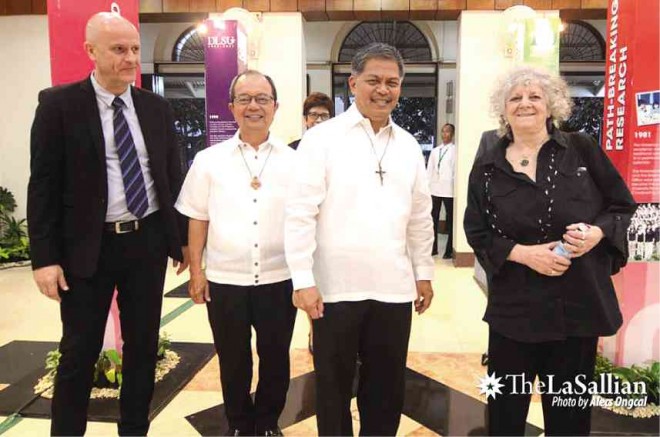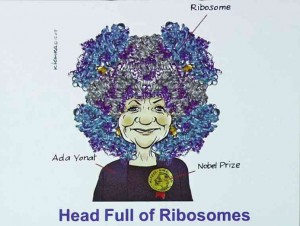
INTERNATIONAL Peace Foundation founding chair Dr. Uwe Morawetz, DLSU president-designate Br. Raymundo Suplido, FSC, and Education Secretary Armin Luistro, FSC, welcome 2009 Nobel Laureate for Chemistry Ada Yonath; (left) YonathÆs caricature from her presentation (www.asianscientist.com/2013/01/features). PHOTO COURTESY OF DLSU

Known as the cell’s protein “factory,” the ribosome “translates” what are called “amino acids”—think of phrases in a sentence—into proteins that play vital functions in the human body, from twitching the muscles and sending out signals to digesting food and providing structure for hair and bone.
In short, the ribosome is essential to the body’s day-to-day operations.
“Ribosomes make the bridges for life,” said Ada Yonath, a professor at Weizmann Institute of Science in Israel and one of the scientists who unearthed the ribosome’s mysteries.
Yonath, who received the 2009 Nobel Prize in Chemistry for her discoveries about the structure and function of the ribosome, spoke recently to nearly 1,500 people at De La Salle University (DLSU).
Her lecture, “From Basic Science to Advanced Medicine—Structures of the Molecules of Life and their Impact on Modern Biomedical Research,” was part of Bridges: Dialogues toward a Culture of Peace, a program facilitated by the Vienna-based International Peace Foundation.
Yonath, who was conferred an honorary Doctor of Science degree by DLSU, told her audience that the road to scientific discovery and the Nobel Prize had not been smooth and easy.
Growing up in an impoverished family, she said she had to start working at age 11 to help her parents make ends meet.
“I had all types of jobs—cleaning, babysitting and providing private tuition to younger children,” she said.
Yonath worked her way through university. She received both her bachelor’s degree in Chemistry and her master’s degree in Biochemistry from Hebrew University of Jerusalem. She earned her Doctor of Philosophy in X-Ray Crystallography in 1968 at Weizmann Institute of Science. She did postdoctoral research at several universities in the United States and Germany.
DLSU’s Suplido, board of trustees chair Jose Pardo and vice chancellor for academics Myrna Austria confer an honorary doctorate in Science on Yonath. Photos courtesy of DLSU
Yonath’s willpower was tested when she did her research, especially when she insisted that she could unlock the secrets of the ribosome.
“I was the subject of a lot of skepticism and criticism,” Yonath said. Her colleagues thought there was nothing more to learn about the ribosome.
Aside from being highly mobile and delicate, the ribosome could deteriorate in three to four days in the laboratory, making its study very difficult, Yonath said.
But, while recovering from a brain concussion sustained in a bicycle accident, Yonath came across an interesting paper about polar bears and how their ribosomes became packed in an orderly fashion before hibernation. The mechanism enabled their ribosomes to remain intact and functional for months.
That was Yonath’s “Eureka” moment.
She developed a technique called cryo-bio-crystallography, which allowed scientists to visualize and study the structure and function of many cellular components, including the ribosome. The procedure led to the creation of three-dimensional (3-D) models that revolutionized structural biology.
Practical application
Yonath’s research also paved the way for the discovery and design of new antibiotics to combat deadly infectious diseases. Many antibiotics used today selectively attack the ribosomes of bacteria while sparing the human ribosomes—killing the microbes but not human cells.
In her lecture, the Nobel laureate highlighted the public health issue of antibiotic resistance. Some antibiotics have become ineffective because genetic mutations have resulted in bacteria immunity.
Yonath said she was now investigating this phenomenon to design new drugs that could overcome antibiotic resistance.
YONATH with Israel’s Deputy Chief of Mission Adam Levene (third from right), Morawetz and top DLSU officials
“Mankind needs to be healthy … health is the most important factor,” said the laboratory scientist who did not stay in the “ivory tower” but made sure her research was used to improve people’s health.
Although Yonath was the first Israeli woman to win the Nobel Prize, the first Middle Eastern woman to win in the sciences, and the first woman in 45 years to win the Chemistry prize, the laureate said she did not think of herself as special.
Scientist, period
“I see myself as a scientist, not as a female scientist. It has nothing to do with my gender,” said Yonath, who also received the L’Oreal-Unesco Award for Women in Science in 2008. Yet she expressed the hope that more women would do research and take up leadership positions in science.
In her presentation, she showed photos of her research team, pointing out that, like her, some of her female colleagues were also mothers who took good care of their children.
Yonath said she never gave the Nobel Prize or any award a thought while doing her ground-breaking research.
“Prizes are nice, but encountering the actual discovery is more fulfilling. It was both emotionally and intellectually satisfying,” she said.
During her lecture, she showed a “certificate” from her granddaughter that read: “The grama of the year is Ada Yonath!”
Since the certificate did not have a date, she said she wondered aloud for which year she was being named best grandma.
Her granddaughter’s reply? “You need to prove that every year!”
Yonath seems to be doing just that both as a grandmother and a scientist.
The writer is a physician and an advocate for global public health issues. He is the campaigner for Healthy Energy Initiative for Health Care Without Harm-Asia and cofounder of #Reimagine Global Health.

